

How to improve the function of the hamstring muscles for speed.
Nigel Hetherington explains how to improve the function of the hamstring muscle group for speed.
In this article, we specifically take a look at the group of three hamstring muscles that run down the back of the leg. The muscles include the semimembranosus, the semitendinosus, and the biceps femoris. These muscles bend (flex) the leg at the knee and also straighten (extend) the leg at the hip joint.
They are especially important for effective sprinting in terms of power and stride length. The way these muscles function, and the forces that result from speed work or sprinting, may lead to injury to this muscle group if insufficient flexibility has been developed (they do control stride length), poor strength is present (particularly relative to the opposing - antagonistic - quadriceps muscle group to the front of the leg) or else basic biomechanics are at fault.
Injuries reduced
The reality is that, provided sufficient and appropriate strengthening work has been carried out in parallel with flexibility development, then the biomechanics of sprinting are better supported. The potential for injury is also significantly reduced. Despite an ever-increasing body of sometimes conflicting information on when and what to stretch, there remain vague or even inaccurate guidelines on how to stretch and indeed why.
Planning
Identifying poor flexibility in the hamstrings is not always as easy as may be imagined since other factors may be involved, including poor technique, other restrictions, or a history of injury. However, once a coach or trainer knows the athlete they are working with, then consistency in performance can usually be established, and any limiting factors identified, such as short stride length.
Consultation with a qualified Physiotherapist at this stage is always a good step to confirm beliefs and to help bring out any history of injury in this area. Stretching should follow the principle of regular controlled progressive static stretching of fully warmed-up muscles in sessions run separately from other training sessions, along with the integration of suitable dynamic stretching activities as part of a warm-up.
Assessment
Use of the classical 'sit and reach test' can help to establish current hamstring flexibility and be used to set a target for improvement within an agreed time.
Exercises - static stretching
There are many examples in the literature of hamstring stretches. However, many of these cases fail to take account of modern best practices (how long, how often, when, etc.), contraindications (opposite knee under pressure in 'hurdles' position or arching of the spine, for example), and specificity (what is being stretched). The best single, most effective, safe, and specific hamstring group stretch from personal experience and the advice of Physiotherapists is the seated, bent leg stretch, as shown in Figure 1.
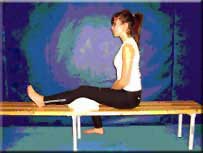 Relaxed |
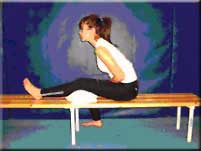 Extended |
Figure 1 - The seated bent knee hamstring stretch
How to start
Sit comfortably on a bench or similar support that allows the foot of the free leg to rest comfortably on the ground. Position suitable support - e.g., cushion under the knee of the leg to be worked to ensure a partially flexed knee is maintained.
Sit 'tall' with hips neutral and move the whole upper body forward toward the leg, keeping alignment throughout - there is no need to stretch out with the arms or to grasp the shin, for example - often this leads to poor posture and an ineffective stretch! Hold the stretch for 10 seconds and repeat three times. Work both legs in turn.
Progression
Extend the hold time to 20-30 seconds. Increase the number of repetitions in a session up to 10. Increase the frequency of stretching to several times per week. Use the 'sit and reach test' to determine improvement. Re-assess every six weeks or so.
This stretch has several advantages, including a comfortable position. There is no unnecessary strain elsewhere in the body; specificity - stretches the hamstring muscle.
NOTE: performing a hamstring stretch with a straight leg is generally not recommended for specifically increasing hamstring muscle flexibility - with the leg straightened the tendency is for the stretch to be taken up by the muscle tendons - try it for yourself and see if you can feel the difference - I guarantee that in 9 out of 10 cases you will feel the stretch in the back of the knee with a straight knee and the 'belly' of the hamstring with a bent knee. The prevalence of guidelines to stretch with a straight knee also underlies the high injury rate.
Exercises - dynamic stretching
Progression to a specific dynamic stretching activity can reap great rewards. Using the standing dynamic 'leg cycling' drill is great for developing coordination, rapid contraction, and relaxation through an extended range (flexibility) and for developing specific hamstring strength/power (figure 2).
Recent research has highlighted the fact that in sprinting, the biceps femoris muscle is the last of the group of three hamstring muscles to 'fire' during the sprint cycle and is often left exposed at the end of the support phase, leading to injury if there are limitations in flexibility, strength, and coordination present.
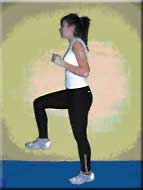 Start |
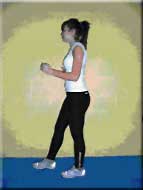 Drive Down |
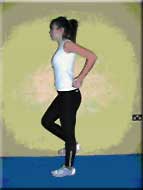 Recovery |
Figure 2 - Phases of the leg cycling drill
How to start
A good start is to work on three sets of ten cycles at around one cycle every two seconds, slowly lifting the knee so that the upper leg is presented parallel to the ground and then driving the leg back and downwards in a rapid, controlled movement with the foot kept fully flexed at the ankle (dorsiflexed). The ball of the foot should be allowed to contact the ground (note: spikes should not be worn for this exercise!).
To best match the specifics of movement in sprinting, the leg should be actively 'recovered' as soon as the foot touches the ground and is directly below the body, i.e., it should not be allowed to swing out of control behind the body - this takes practice! Work both legs evenly unless seeking to address an imbalance!
Progression
This activity can be made progressive in terms of the cycling rate (up to 3 per second), the duration (up to 15 seconds), the range of movement (particularly knee lift and height of foot recovery or knee flexion), and the focus within the cycle (developing to a smooth, complete cycling action).
Summary
Combining controlled, static stretching with a suitable progressive, dynamic workout can improve sprinting performance, dramatically reduce the chance of hamstring injury, and can be used extensively in rehabilitation following muscle injury.
Article Reference
This article first appeared in:
- HETHERINGTON, N. (2005). How to improve the function of the hamstring muscles for speed. Brian Mackenzie's Successful Coaching, (ISSN 1745-7513/ 28 / December 2005-January 2006), p. 10-11
Page Reference
If you quote information from this page in your work, then the reference for this page is:
- HETHERINGTON, N. (2005) How to improve the function of the hamstring muscles for speed [WWW] Available from: https://www.brianmac.co.uk/articles/scni28a4.htm [Accessed
About the Author